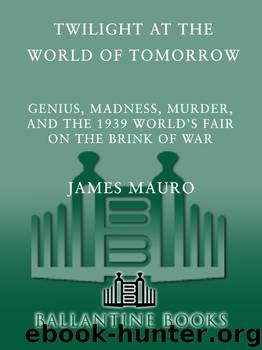Twilight at the World of Tomorrow by James Mauro

Author:James Mauro [Mauro, James]
Language: eng
Format: epub, mobi
ISBN: 978-0-345-52178-1
Publisher: Random House Publishing Group
Published: 2010-06-21T16:00:00+00:00
* In today’s dollars, imagine paying someone about $100 to change a lightbulb.
Einstein and his sister Maja inspect the Haifa diorama in the Palestine Pavilion. The exhibit’s trick-mirror effect perpetually fascinated him. (Courtesy of the New York Public Library)
16
PALESTINE VS. PANCHO VILLA
Gerald Wendt, director of the American Institute of New York City, had put together the Science Advisory Committee1 to the World’s Fair at the beginning of 1938 and immediately asked Albert Einstein to become its honorary chairman. Einstein accepted, though somewhat reluctantly. Science was taking a wrong turn2 in the 1930s, he and many others felt. In January 1939, in a speech praising Nobel Prize–winning novelist Thomas Mann, Einstein made several astounding statements that revealed his disappointment with the purely introspective life, particularly in the face of current events.
“The standard-bearers of intellect have grown weak … and the powers of darkness have been strengthened thereby,” he declared. “Weakness of attitude becomes weakness of character; it becomes lack of power to act with courage proportionate to danger.”
Moreover, corporate science, geared essentially toward the singular goals of new technology, new products, and a greater desire for consumerism, was the dominant force of the day. Right or wrong, science in general lost a great deal of prestige after the Depression hit. As Einstein had predicted several years earlier at Caltech, in 1939 as many as one in four unemployed Americans believed they had lost their jobs because a machine had taken it over.
Despite Wendt’s assurances that Corporate America would not dominate the scientific approach at the World’s Fair, it became obvious rather quickly that that wasn’t going to be the case. Although the Theme Committee was full of designers, artists, and architects, it was sorely lacking in scientists. As early as 1936, Whalen had been fielding questions about how the World of Tomorrow was going to be conceived with “the apparent omission of science … in connection with the plans for the Fair.”
Stephen Voorhees answered that science was to be recognized “only in its applications.” Meaning what, exactly? Nylon? Fluorescent lighting? Television?
Whalen spun it in a better light. Science wouldn’t exactly have its own exhibit per se, but the overall goal of the World’s Fair was “to tell the whole story3 of modern scientific research instead of a single chapter,” he said. “As far as practical, to add a working, scientific display to every major exhibit.”
In other words, gadgets and magic.
Part of the difficulty came from the scientific community itself, which could never quite manage to get its ideas and meaning across in a way that everyone could understand. In the middle of 1937, Columbia professor Harold Urey attempted to enumerate what scientists were trying to do with their work: “We wish to abolish4 drudgery, discomfort and want from the lives of men and bring them pleasure, comfort, leisure and beauty.”
“Well, yes!” one can imagine a Westinghouse executive pounding his fist on a conference table and shouting. “That’s exactly what we want, too!” So it came as no surprise that in one of Westinghouse’s live performances, an actress portraying “Mrs.
Download
Twilight at the World of Tomorrow by James Mauro.mobi
This site does not store any files on its server. We only index and link to content provided by other sites. Please contact the content providers to delete copyright contents if any and email us, we'll remove relevant links or contents immediately.
| African Americans | Civil War |
| Colonial Period | Immigrants |
| Revolution & Founding | State & Local |
Cat's cradle by Kurt Vonnegut(15184)
Pimp by Iceberg Slim(14393)
4 3 2 1: A Novel by Paul Auster(12283)
Underground: A Human History of the Worlds Beneath Our Feet by Will Hunt(12024)
The Radium Girls by Kate Moore(11921)
Wiseguy by Nicholas Pileggi(5671)
Perfect Rhythm by Jae(5324)
American History Stories, Volume III (Yesterday's Classics) by Pratt Mara L(5256)
The Fire Next Time by James Baldwin(5249)
Paper Towns by Green John(5089)
Pale Blue Dot by Carl Sagan(4912)
A Higher Loyalty: Truth, Lies, and Leadership by James Comey(4843)
The Mayflower and the Pilgrims' New World by Nathaniel Philbrick(4423)
The Doomsday Machine by Daniel Ellsberg(4416)
Killers of the Flower Moon: The Osage Murders and the Birth of the FBI by David Grann(4386)
The Sympathizer by Viet Thanh Nguyen(4305)
Too Much and Not the Mood by Durga Chew-Bose(4272)
The Borden Murders by Sarah Miller(4247)
Sticky Fingers by Joe Hagan(4101)
